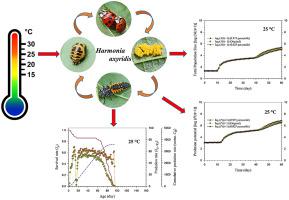Crop Protection ( IF 2.5 ) Pub Date : 2022-05-27 , DOI: 10.1016/j.cropro.2022.106029 Yasir Islam , Ali Güncan , Yadong Fan , Xingmiao Zhou , Afifa Naeem , Farhan Mahmood Shah

|
Pest management strategies relying on biocontrol agents may be altered by climate change because temperature regulates biological rates from individuals to populations. We investigated predation and development of Harmonia axyridis foraging on Acyrthosiphon pisum at four different temperatures (15, 20, 25, and 30 °C). Age-stage, two-sex life table analysis of the predator was conducted. Computer projections based on bootstrap percentile confidence intervals were used for assessment of population growth and predation parameters. H. axyridis development and predation varied across temperature. Development was much slower at 15 °C than at warmer temperatures. Pre-adult stage mean duration was 41.25 d at 15 °C, but this decreased to 28.67, 18.35, and 13.23 d at 20, 25, and 30 °C, respectively. The intrinsic rate of increase was 0.0805 d−1 at 15 °C, but this increased to 0.1009, 0.1324, 0.1813 d−1 at 20, 25, and 30 °C, respectively. The mean generation time (T) was 71.96 d at 15 °C, which decreased to 54.68, 42.64 and 29.96 d at 20, 25, and 30 °C, respectively. The highest intrinsic rate of increase (r) and finite rate of increase (λ) were obtained at 30 °C, while the highest fecundity occurred at 15 °C with 743.68 eggs/female. The net predation rates (C0) were 4445.28, 4299.30, 3602.18, and 2624.20 aphids at 15, 20, 25, and 30 °C, respectively. Population and predation projections were proportional to temperature. These results are useful for modelling the population response of H. axyridis to climate change and tailoring IPM strategies to altered climates.
中文翻译:

在四种不同温度下饲养于 Acyrthosiphon pisum (Harris) (Hemiptera: Aphididae) 上的 Harmonia axyridis Pallas (Coleoptera: Coccinellidae) 的年龄阶段、两性生活表和捕食参数
依赖生物防治剂的害虫管理策略可能会因气候变化而改变,因为温度会调节从个体到种群的生物速率。我们调查了异色瓢虫在四种不同温度(15、20、25 和 30 °C)下以豌豆为食的捕食和发育情况。对捕食者进行年龄阶段、两性生活表分析。基于自举百分位置信区间的计算机预测用于评估种群增长和捕食参数。异色瓢虫发育和捕食随温度变化。在 15 °C 下的发育比在温暖的温度下要慢得多。成年前阶段平均持续时间在 15°C 时为 41.25 天,但在 20、25 和 30°C 时分别降至 28.67、18.35 和 13.23 天。 在 15 °C 时,固有增长率为 0.0805 d -1 ,但在 20、25 和 30 °C 时分别增加到 0.1009、0.1324、0.1813 d -1 。平均生成时间 ( T ) 在 15 °C 时为 71.96 d,在 20、25 和 30 °C 时分别下降到 54.68、42.64 和 29.96 d。最高的内在增长率 ( r ) 和有限的增长率 ( λ) 在 30 °C 时获得,而最高的繁殖力发生在 15 °C 时,有 743.68 个卵子/雌性。15、20、25、30℃时,蚜虫的净捕食率(C 0)分别为4445.28、4299.30、3602.18、2624.20只。人口和捕食预测与温度成正比。这些结果有助于模拟异色瓢虫种群对气候变化的反应,并根据气候变化调整 IPM 策略。









































 京公网安备 11010802027423号
京公网安备 11010802027423号